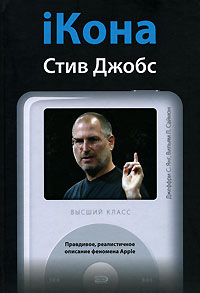"Icon" of the IT world

In 2007, the book “I. Steve Jobs, sponsored by Jeffrey S. Young and William L. Simon. The first is a journalist, the second is the author of more than 20 books on various topics. And this same book on the occasion of fate (I laugh) fell into my hands.
I confess, “i” is the first book dedicated to Jobs and Apple in particular, which I read. Previously, there were only articles, publications on blogs and other various materials that somehow caught my eye. Therefore, the review may be too subjective. And now everything is in order.
I want to immediately warn the reader if you are afraid to be disappointed in Steve Jobs, then do not read any further this article, nor the book I called. I'm serious :-)
')
The book consists of three parts:
1. Ups and downs. As you know, here we are talking about how it all began, how the “garage” company appeared, about the first Apple computers. And most importantly, about exile from their own company "icons". As the journalists later say: "This time Jobs lost the war." Even from this part you will learn about the foster family of the great Steve.
2. New beginning. After Jobs left Apple (not on his own), he had to start a new business. Naturally, the new is well forgotten old. Having created the Next company for the production of powerful computers for business, internally Steve Jobs wanted to compete with Apple. True, he was not allowed, because he was afraid of competition, and that he would not have been able to conceal sin. To the same journalists, the owner of the newly founded company once said: “It’s hard to imagine that a company worth $ 2 billion and with a staff of more than 4,300 people (speaking of Apple) cannot compete with a team of six people in blue jeans.” Journalists liked it. They very much loved and love Steve for his eloquence and public interest in his person. Learn how Jobs bought Pixar, having invested an insane amount of money into it, signed a cooperation agreement with Disney.
“New beginning” is the largest part, which is devoted entirely to the time when Jobs was far from what was happening at Apple, the company he created and without which he could not.
3. Formation of the future. There are too many repetitions in this part. I will be more precise: a number of thoughts have already sounded in the previous parts. Then you will read about the successful IPO of Pixar and how Steve became a millionaire again. About returning to Apple and creating an iPod. It seems to me that if Steve had not returned, then Apple would now be a completely different company.
And now about a fly in the ointment.
The authors of the book about Steve Jobs really make it clear that the person who is considered an “icon” did not actually create anything. All ideas allegedly belonging to Steve were actually put forward either by his friends, or by colleagues and subordinates. But Steve always took it upon himself. He did not value friendship and family (until a certain time). For example, he didn’t admit his daughter Liza, he even refused to pay her meager child support, despite the fact that they (mother and daughter) had to live for some time but not exist.
The way Jobs dealt with employees can only be called slavery. The working week should not be equal to 40 hours, as is customary, but at least 90 (!). In general, employees of a company where Steve is at the helm should not only forget about family and personal life, but also about what to eat and sleep. Of course, I exaggerate a little, but the work week at 90 o'clock is too much.
Attitude towards partners was no better than towards colleagues. Steve Jobs could easily negotiate with large companies for a long time (more than a year), but at the very last moment, on the day of signing, he decided that the transaction would not take place. Why so? I do not know.
Steve's attitude toward life changed after he met a woman who became his wife. Details, already read for yourself.
Conclusions that I made after reading the book.
* Business is an exciting game, like a war.
* Brilliant and unique product - this is only part of the success. The product must show the consumer and teach him to use it.
* In business, you need a leader, followed by not only employees, but also the crowd.
As for my recommendation as to whether or not you should read this book, I have not been given a definite advice. Most likely, read, but do not read. Personally, I really liked the first chapters, where Steve is still young and actively enjoys Buddhism. :-) But this passage more closely resembles a fictional narrative, rather than business literature.
By the way, if you have already read the book, then share your impressions. It is very interesting what conclusions you made after reading this book.
Source: RetailMedia <img
Source: https://habr.com/ru/post/13121/
All Articles